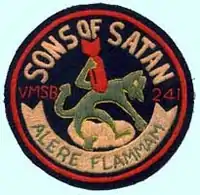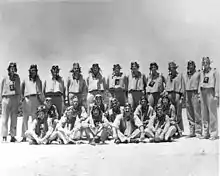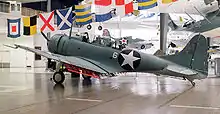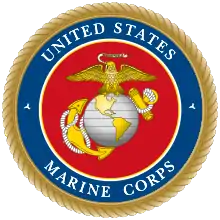VMA-241
Marine Attack Squadron 241 (VMA-241) was an A-4 Skyhawk attack squadron in the United States Marine Corps. Also known as the “Sons of Satan”, it was part of the Marine Forces Reserve and based at Naval Air Station Los Alamitos, California, from 1946 through the 1960s. Originally commissioned during World War II, the squadron sustained enormous losses during the Battle of Midway and also saw extensive combat while providing close air support during the Philippines Campaign (1944–45).
| Marine Attack Squadron 241 | |
|---|---|
 VMSB-241 insignia | |
| Active | March 1, 1942 - July 15, 1945[1]
1946 - 1960s |
| Country | United States |
| Branch | USMC |
| Type | Attack Squadron |
| Role | Close air support Air interdiction |
| Part of | Inactive |
| Nickname(s) | Sons of Satan[2] |
| Motto(s) | "Alere Flammam" "To Feed the Flames" |
| Tail Code | QG |
| Engagements | World War II * Battle of Midway * Philippines Campaign (1944–45) |
| Aircraft flown | |
| Attack | A4A Skyhawk |
| Bomber | SB2U-3 Vindicator SBD Dauntless |
History
Battle of Midway
Marine Scout Bomber Squadron 241 (VMSB-241) was formed at Midway Atoll on March 1, 1942 as part of Marine Aircraft Group 22 (MAG-22).[1] From June 4–6, 1942 the squadron fought in the Battle of Midway where it lost 23 of its 30 aircraft and suffered 22 killed in action and 14 wounded in action. At 0605 on June 4 the squadron received word to scramble all of their aircraft to attack a Japanese aircraft carrier task force that had been spotted 180 miles of the atoll.[3] VMSB-241 had divided into two striking units, the first composed of 16 SBD-2s led by Major Lofton Henderson, and the second of 11 SB2U-3s commanded by Major Benjamin W. Norris.[4] Henderson's group climbed to 9,000 feet to locate the enemy carriers, which were then undergoing an attack from United States Navy TBFs and the B-26s. Fliers of this group sighted the Japanese ships at 0744, but as the SBDs spiraled down they were set upon by swarms of Nakajima B5Ns and A6M Zeros flying air cover, which were soon reinforced by more fighters from the carriers below. Henderson and several other were shot down (only eight of these planes got back to Midway) and the strike scored no hits although some were claimed. At 1700 a burning enemy carrier was reported 200 miles northwest of Midway, and Major Norris prepared VMSB-241's six operational SBD-2s and five SB2U-3s for a night attack. The planes took off at 1900, but could not find the carrier. Major Norris failed to return from this mission, although the other pilots managed to come home by the light of oil fires and the antiaircraft searchlights which were turned up as beacons.[5][6]
Early in the morning of June 5, 1942, Captain Richard E. Fleming's SB2U-3 Vindicator was hit and on fire as he continued his attack on the Japanese cruiser Mikuma. He maintained his dive, released his bomb and crashed directly into the cruiser.[7] For this action he was posthumously awarded the Medal of Honor.[8]
1943 & 1944
VMSB-241 remained on Midway Atoll until March 1943 when it departed for Marine Corps Air Station Ewa, Territory of Hawaii. On April 24, 1943, VMSB-241, now part of arrived at Tutuila where it remained for the next eight months.[9] On December 16, 1943 the squadron moved up to Efate. Remained on island until February 2, 1944 when it moved to Piva on Bougainville.[9] The squadron returned to Efate on March 18. On May 13, 1944 the squadron's flight echelon moved to Emirau to begin conducting bombing missions against the Japanese garrison on Rabaul.[9] Ground echelon moved to Munda, Solomon Islands on Jun 18 and was joined by the flight echelon on July 8.[9]
Philippines
On September 20, 1944, General George Kenney, Commander of the Far East Air Forces arrived on Bougainville and informed 1st Marine Aircraft Wing leadership that all of the wing's dive bomber squadrons were to be utilized to support the Sixth United States Army during the upcoming campaign to liberate Luzon.[10] In preparation for departure, VMSB-241 was ferried from Munda to Bougainville on November 22-23.[11] Marine Aircraft Group 24's ground echelons sailed from Bougainville on December 12 onboard four transport vessels.[11] VMSB-241's flight echelon departed Emirau on January 19 heading for Peleliu via Momote and Owi. On January 25, 1944, the squadron finally got the nod to fly into the newly built airstrip at Mangaldan.[12][13] On January 27, 1945, Major Ben Manchester, Commanding Officer of VMSB-241, led 18 of the squadron's SBDs in the first Marine Corps airstrikes on Luzon. The squadron attacked military targets in the vicinity of San Fernando.[14][15][16] February and March saw VMSB-241 and the rest of MAG-24 providing close air support, flank protection and reconnaissance for the 1st Cavalry Division during its drive towards Manila.[17]
Combat operations on Luzon were discontinued on April 2 to allow the squadron to prepare for follow on operations in Mindanao.[18] VMSB-241 departed Clark Air Base on April 20 bound for Malabang, Mindanao.[18] The squadron, along with the rest of MAG-24, was tasked with supporting the 24th and 31st Infantry Divisions in their eastward push across Mindinao.[19]
During its time in the Philippines, VMSB-241 suffered six Marine killed in action and another six Marines wounded in action.[20] On July 16, 1945, while stationed at Titcomb Field south of Malabang, VMSB-241 was ordered to decommission along with VMSB-133 by 1st MAW General Order No. 18-45.[21][22]
Reserve years
Beginning in 1946, the squadron became part of the Marine Air Reserve based out of Naval Air Station Los Alamitos, California. It was brought back onto active duty in August 1950 at the outbreak of the Korean War and sent to Marine Corps Air Station El Toro, California where the unit's members were dispersed amongst other active duty units.
Gallery
 A U.S. Marine Corps Douglas SBD-2 Dauntless of Marine scout bombing squadron VMSB-241 on Midway Atoll, 4 June 1942.
A U.S. Marine Corps Douglas SBD-2 Dauntless of Marine scout bombing squadron VMSB-241 on Midway Atoll, 4 June 1942. Photo from May 1942 showing the officers from VMSB-241.
Photo from May 1942 showing the officers from VMSB-241. Two Vought SB2U-3 Vindicators of VMSB-241 take off from Midway Atoll. Plane No. 6 in the foreground (BuNo 2045) was flown on June 4, 1942 by 2nd Lt James H. Marmande with PFC Edby Colvin as gunner. This plane was flown in the morning attack against the Japanese and disappeared on the night of 4/5 June about 16 km (10 mi) from Midway.
Two Vought SB2U-3 Vindicators of VMSB-241 take off from Midway Atoll. Plane No. 6 in the foreground (BuNo 2045) was flown on June 4, 1942 by 2nd Lt James H. Marmande with PFC Edby Colvin as gunner. This plane was flown in the morning attack against the Japanese and disappeared on the night of 4/5 June about 16 km (10 mi) from Midway. This SBD-2 was one of sixteen dive bombers of VMSB-241 launched from Midway on the morning of 4 June. Holed 219 times in the attack on the carrier Hiryū, it survives today at the National Naval Aviation Museum at Pensacola, Florida.[23]
This SBD-2 was one of sixteen dive bombers of VMSB-241 launched from Midway on the morning of 4 June. Holed 219 times in the attack on the carrier Hiryū, it survives today at the National Naval Aviation Museum at Pensacola, Florida.[23]
Notable Members
- Richard E. Fleming - Medal of Honor recipient for heroic action at the Battle of Midway.[24]
- Armond H. DeLalio - recipient of the Navy Cross for actions during the Battle of Midway.[25]
- Albert William Tweedy, Jr. - recipient of the Navy Cross for actions during the Battle of Midway.[26]
See also
- United States Marine Corps Aviation
- List of United States Marine Corps aircraft squadrons
- List of decommissioned United States Marine Corps aircraft squadrons
Citations
- Rottman 2002, pp. 443.
- Boggs 1951, pp. 68.
- Tyler, Captain Marshall A. (Commanding Officer VMSB-241) (1996). "Report of Activities of VMSB-241 during June 4 and June 5, 1942" (PDF). United States Marine Corps. Retrieved 2009-02-24. Cite journal requires
|journal=(help) - Shettle 2001, pp. 90.
- Mersky 1983, pp. 36-39.
- Sherrod 1952, pp. 56-62.
- Hubler & DeChant 1944, pp. 35.
- Hill Goodspeed (May 2003), Always Faithful (PDF), Naval Aviation News, retrieved 10 Mar 2016
- Sherrod 1952, pp. 465.
- Boggs 1951, pp. 56-58.
- Boggs 1951, pp. 63.
- Boggs 1951, pp. 69.
- Sherrod 1952, pp. 299.
- Astor 2005, pp. 304.
- Sherrod 1952, pp. 300.
- Boggs 1951, pp. 71.
- Sherrod 1952, pp. 300-306.
- Boggs 1951, pp. 105.
- Boggs 1951, pp. 128.
- Boggs 1951, pp. 142.
- Boggs 1951, pp. 131.
- Tillman 1998, pp. 76.
- SBD-2 Aircraft, Bureau Number 2106, National Naval Aviation Museum Collections, 13 January 1994, archived from the original on 29 June 2016, retrieved 12 April 2016
- "Captain Richard E. Fleming, USMCR (Deceased)". www.usmcu.edu. United States Marine Corps. Retrieved August 9, 2020.
- "Armond H. Delalio". Military Times.
- "VMA-241". Hall of Valor. Military Times. Retrieved August 9, 2020.
References
- Bibliography
- Astor, Gerald (2005). Semper Fi in the Sky - The Marine Air Battles of World War II. New York: Random House. ISBN 0-89141-877-6.
- Hubler, Richard G.; DeChant, John A (1944). Flying Leathernecks – The Complete Record of Marine Corps Aviation in Action 1941 – 1944. Garden City, New York: Doubleday, Doran & Co., Inc.
- Mersky, Peter B. (1983). U.S. Marine Corps Aviation - 1912 to the Present. Nautical and Aviation Publishing Company of America. ISBN 0-933852-39-8.
- Rottman, Gordon L. (2002). U.S. Marine Corps World War II Order of Battle - Ground and Air Units in the Pacific War, 1939 - 1945.’’. Greenwood Press. ISBN 0-313-31906-5.
- Sherrod, Robert (1952). History of Marine Corps Aviation in World War II. Washington, D.C.: Combat Forces Press.
- Shettle, M. L. (2001). United States Marine Corps Air Stations of World War II. Bowersville, Georgia: Schaertel Publishing Co. ISBN 0-964-33882-3.
- Tillman, Barrett (1998). SBD Dauntless Units of World War 2. Osprey Publishing.
- Web
- Boggs, Charles W. (1951). Marine Aviation in the Philippines (PDF). Washington, D.C.: Marine Corps Historical Center. Retrieved 7 August 2020.
- VMA-241 Sons of Satan
